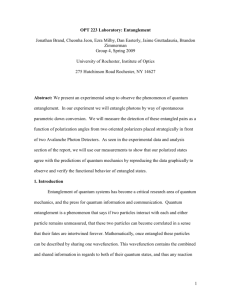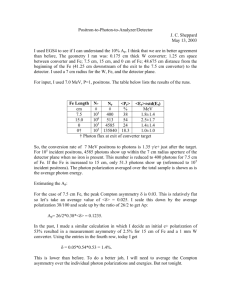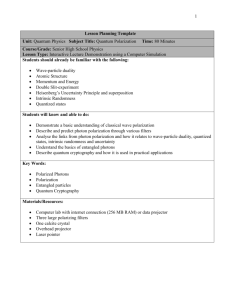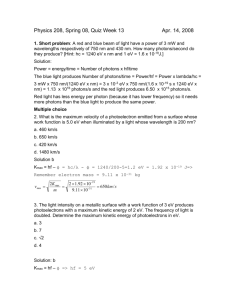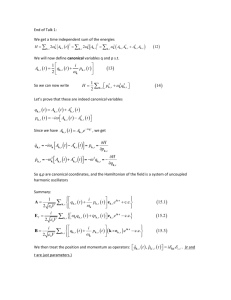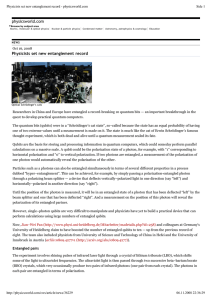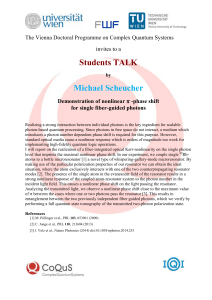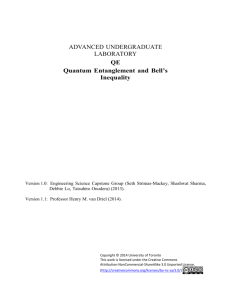OPT223_Group_1_QuantumEntanglement
advertisement
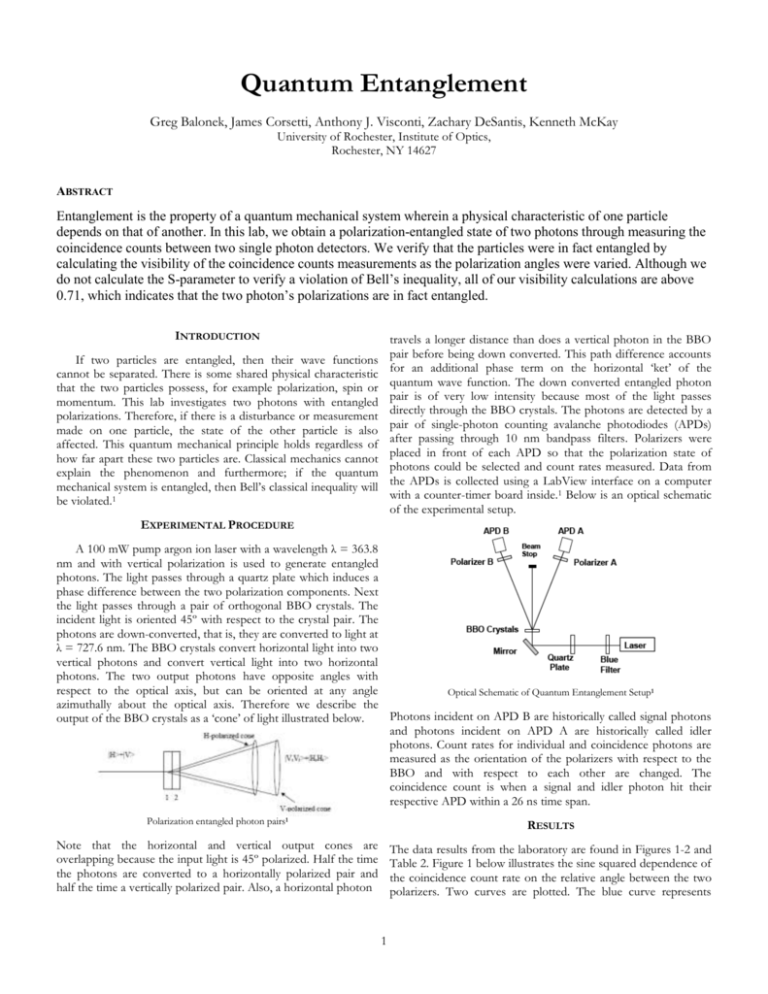
Quantum Entanglement Greg Balonek, James Corsetti, Anthony J. Visconti, Zachary DeSantis, Kenneth McKay University of Rochester, Institute of Optics, Rochester, NY 14627 ABSTRACT Entanglement is the property of a quantum mechanical system wherein a physical characteristic of one particle depends on that of another. In this lab, we obtain a polarization-entangled state of two photons through measuring the coincidence counts between two single photon detectors. We verify that the particles were in fact entangled by calculating the visibility of the coincidence counts measurements as the polarization angles were varied. Although we do not calculate the S-parameter to verify a violation of Bell’s inequality, all of our visibility calculations are above 0.71, which indicates that the two photon’s polarizations are in fact entangled. INTRODUCTION travels a longer distance than does a vertical photon in the BBO pair before being down converted. This path difference accounts for an additional phase term on the horizontal ‘ket’ of the quantum wave function. The down converted entangled photon pair is of very low intensity because most of the light passes directly through the BBO crystals. The photons are detected by a pair of single-photon counting avalanche photodiodes (APDs) after passing through 10 nm bandpass filters. Polarizers were placed in front of each APD so that the polarization state of photons could be selected and count rates measured. Data from the APDs is collected using a LabView interface on a computer with a counter-timer board inside.1 Below is an optical schematic of the experimental setup. If two particles are entangled, then their wave functions cannot be separated. There is some shared physical characteristic that the two particles possess, for example polarization, spin or momentum. This lab investigates two photons with entangled polarizations. Therefore, if there is a disturbance or measurement made on one particle, the state of the other particle is also affected. This quantum mechanical principle holds regardless of how far apart these two particles are. Classical mechanics cannot explain the phenomenon and furthermore; if the quantum mechanical system is entangled, then Bell’s classical inequality will be violated.1 EXPERIMENTAL PROCEDURE A 100 mW pump argon ion laser with a wavelength λ = 363.8 nm and with vertical polarization is used to generate entangled photons. The light passes through a quartz plate which induces a phase difference between the two polarization components. Next the light passes through a pair of orthogonal BBO crystals. The incident light is oriented 45º with respect to the crystal pair. The photons are down-converted, that is, they are converted to light at λ = 727.6 nm. The BBO crystals convert horizontal light into two vertical photons and convert vertical light into two horizontal photons. The two output photons have opposite angles with respect to the optical axis, but can be oriented at any angle Optical Schematic of Quantum Entanglement Setup1 azimuthally about the optical axis. Therefore we describe the Photons incident on APD B are historically called signal photons output of the BBO crystals as a ‘cone’ of light illustrated below. and photons incident on APD A are historically called idler photons. Count rates for individual and coincidence photons are measured as the orientation of the polarizers with respect to the BBO and with respect to each other are changed. The coincidence count is when a signal and idler photon hit their respective APD within a 26 ns time span. Polarization entangled photon pairs1 RESULTS Note that the horizontal and vertical output cones are overlapping because the input light is 45º polarized. Half the time the photons are converted to a horizontally polarized pair and half the time a vertically polarized pair. Also, a horizontal photon The data results from the laboratory are found in Figures 1-2 and Table 2. Figure 1 below illustrates the sine squared dependence of the coincidence count rate on the relative angle between the two polarizers. Two curves are plotted. The blue curve represents 1 measurements made with the polarizer for APD A at 0º with respect to the BBO pair as the polarizer for APD B was varied from 0º to 360º. The yellow curve represents measurements made with the polarizer for APD A at 90º with respect to the BBO pair as the polarizer for APD B was again varied from 0º to 360º. Curve A: 0 deg A: 90 deg Visibility 0.76 0.74 Table 1. Note that the visibility for both curves is above 0.71, which implies that we have achieved polarization-entangled photons. DISCUSSION QUESTIONS Two particles are considered entangled when their wave functions are linked so that one object can no longer be described without mention of the other. Any measurement performed on one particle will change the state of the other. Mathematically, this means that the wave functions cannot be factored. In this particular lab, entangled photons are produced with two perpendicular BBO crystals through a process called spontaneous parametric down-conversion. Spontaneous parametric downconversion is the process where a high energy photon is split into two other photons at half the energy. To prove that the photons were entangled, a violation of Bell’s inequalities was measured to illustrate non-classical behavior. Simply, a sine squared dependence with a visibility greater than the classical limit was shown for the relationship between coincidence counts and polarizer angle. The maximum coincidence counts occurred when the difference in angle between the two polarizers was 90 degrees. The minimum occurred when the difference in the angle was a multiple of 180 degrees. The count rate of single photons did not change with angle. The sine squared dependence matches with the equations derived in section 4 for the probability of coincidence. Figure 1: Coincidence count vs. polarization angle Note that the coincidence count for the blue curve varies as sine squared with respect to the polarization angle of APD B. Subtracting the 90º offset of the yellow curve would also yield sine squared dependence. Below is a plot of the single count for APD B as the polarization angle is varied. The individual photon count does not vary over angle, whereas the coincidence count does. Also we made measurements of maximum and minimum of similar curves at polarizer A settings 45º and 135º we obtained fringe visibility of 0.896 and 0.914 respectively. REFERENCES 1. “Entanglement and Bell’s Inequalities.” Dr. Svetlana Lukishova. University of Rochester, Institute of Optics. Fall 2008. Figure 2: Single count vs. polarization angle From the coincidence count measurements in Figure 1, the visibility is calculated in Table 1 below. 2


